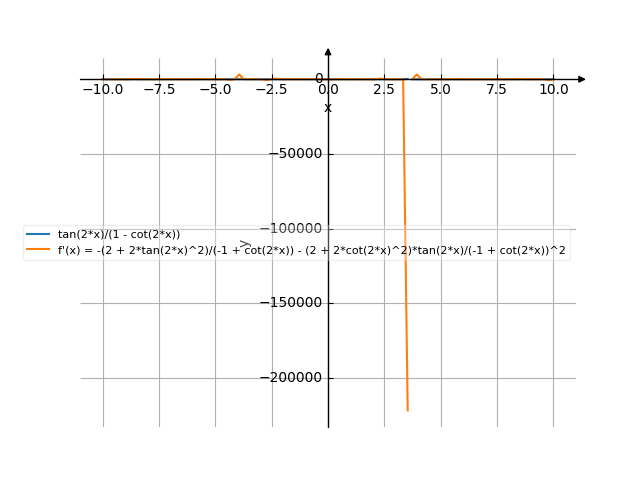Derivative of (tan2x)/(1-cot2x)
The solution
tan(2*x) ------------ 1 - cot(2*x)
d / tan(2*x) \ --|------------| dx\1 - cot(2*x)/
-
Apply the quotient rule, which is:
and .
To find :
-
Rewrite the function to be differentiated:
-
Apply the quotient rule, which is:
and .
To find :
-
Let .
-
The derivative of sine is cosine:
-
-
Then, apply the chain rule. Multiply by :
-
The derivative of a constant times a function is the constant times the derivative of the function.
-
Apply the power rule: goes to
So, the result is:
-
The result of the chain rule is:
-
To find :
-
Let .
-
The derivative of cosine is negative sine:
-
-
Then, apply the chain rule. Multiply by :
-
The derivative of a constant times a function is the constant times the derivative of the function.
-
Apply the power rule: goes to
So, the result is:
-
The result of the chain rule is:
-
Now plug in to the quotient rule:
To find :
-
Differentiate term by term:
-
The derivative of the constant is zero.
-
The derivative of a constant times a function is the constant times the derivative of the function.
-
There are multiple ways to do this derivative.
Method #1
-
Rewrite the function to be differentiated:
-
Let .
-
Apply the power rule: goes to
-
Then, apply the chain rule. Multiply by :
-
Let .
-
-
Then, apply the chain rule. Multiply by :
-
The derivative of a constant times a function is the constant times the derivative of the function.
-
Apply the power rule: goes to
So, the result is:
-
The result of the chain rule is:
-
The result of the chain rule is:
Method #2
-
Rewrite the function to be differentiated:
-
Apply the quotient rule, which is:
and .
To find :
-
Let .
-
The derivative of cosine is negative sine:
-
-
Then, apply the chain rule. Multiply by :
-
The derivative of a constant times a function is the constant times the derivative of the function.
-
Apply the power rule: goes to
So, the result is:
-
The result of the chain rule is:
-
To find :
-
Let .
-
The derivative of sine is cosine:
-
Then, apply the chain rule. Multiply by :
-
The derivative of a constant times a function is the constant times the derivative of the function.
-
Apply the power rule: goes to
So, the result is:
-
The result of the chain rule is:
-
Now plug in to the quotient rule:
-
So, the result is:
-
The result is:
-
Now plug in to the quotient rule:
Now simplify:
The answer is:
2 / 2 \
2 + 2*tan (2*x) \-2 - 2*cot (2*x)/*tan(2*x)
--------------- + ---------------------------
1 - cot(2*x) 2
(1 - cot(2*x))
/ / 2 \ \
| / 2 \ | 1 + cot (2*x) | |
| / 2 \ / 2 \ \1 + cot (2*x)/*|- ------------- + cot(2*x)|*tan(2*x)|
| / 2 \ \1 + cot (2*x)/*\1 + tan (2*x)/ \ -1 + cot(2*x) / |
8*|- \1 + tan (2*x)/*tan(2*x) - ------------------------------- + -----------------------------------------------------|
\ -1 + cot(2*x) -1 + cot(2*x) /
------------------------------------------------------------------------------------------------------------------------
-1 + cot(2*x)
/ / 2 \ \
| | / 2 \ / 2 \ | |
| / 2 \ | 2 3*\1 + cot (2*x)/ 6*\1 + cot (2*x)/*cot(2*x)| / 2 \|
| \1 + cot (2*x)/*|1 + 3*cot (2*x) + ------------------ - --------------------------|*tan(2*x) / 2 \ / 2 \ | 1 + cot (2*x) ||
| | 2 -1 + cot(2*x) | / 2 \ / 2 \ 3*\1 + cot (2*x)/*\1 + tan (2*x)/*|- ------------- + cot(2*x)||
| / 2 \ / 2 \ \ (-1 + cot(2*x)) / 3*\1 + cot (2*x)/*\1 + tan (2*x)/*tan(2*x) \ -1 + cot(2*x) /|
16*|- \1 + tan (2*x)/*\1 + 3*tan (2*x)/ - -------------------------------------------------------------------------------------------- - ------------------------------------------ + --------------------------------------------------------------|
\ -1 + cot(2*x) -1 + cot(2*x) -1 + cot(2*x) /
-----------------------------------------------------------------------------------------------------------------------------------------------------------------------------------------------------------------------------------------------------
-1 + cot(2*x)


![Find the derivative of y' = f'(x) = (tan2x)/(1-cot2x) ((tangent of 2x) divide by (1 minus cotangent of 2x)) - functions. Find the derivative of the function at the point. [THERE'S THE ANSWER!] (tan2x)/(1-cot2x)](/media/krcore-image-pods/176/hash/derivative/9/88/f052da9edc114333a91b8aadcab95.png)
 Derivative of sqrt(x)
Derivative of sqrt(x)
 Derivative of cbrt(x)
Derivative of cbrt(x)
 Derivative of x^(4/5)
Derivative of x^(4/5)
 Derivative of (tan2x)/(1-cot2x)
Derivative of (tan2x)/(1-cot2x)